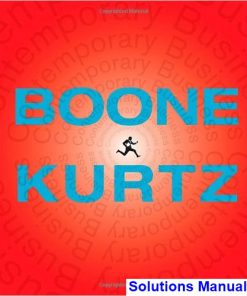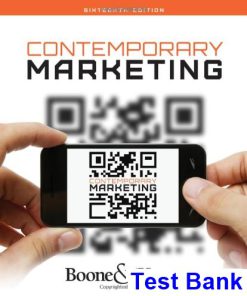Contemporary Business Canadian 1st Edition Boone Test Bank
You may also like
Contemporary Business Canadian 1st Edition Boone Test Bank

Product details:
- ISBN-10 : 1118729056
- ISBN-13 : 978-1118729052
- Author: Boone & Kurtz
Best-selling authors Boone & Kurtz continue to lead the market with their innovative, up-to-the-minute texts. This 2000 paperback is an updated version of the market-leading Contemporary Business text at a reduced price for the student. Equipped with the same standard-setting features and ancillaries as the hardbound version, this paperback is filled with updated materials, all of which reflect currency changes in the business world.
Table contents:
- CHAPTER 1 The Changing Face of Business
- Chapter 1 Overview
- 1.1 What is Business?
- 1.2 Factors of Production
- 1.3 The Private Enterprise System
- 1.4 Seven Eras in the History of Business
- 1.5 Current Business Workforce Trends
- 1.6 Today’s Manager
- 1.7 What Makes a Company Admired?
- What’s Ahead
- Chapter in Review
- CHAPTER 2 Business Ethics and Social Responsibility
- Chapter 2 Overview
- 2.1 Concern for Ethical and Societal Issues
- 2.2 The Contemporary Ethical Environment
- 2.3 How Organizations Shape Ethical Conduct
- 2.4 Acting Responsibly to Satisfy Society
- 2.5 Responsibilities to Investors and the Financial Community
- What’s Ahead
- Chapter in Review
- CHAPTER 3 Economic Challenges Facing Business Today
- Chapter 3 Overview
- 3.1 Microeconomics: The Forces of Demand and Supply
- 3.2 Macroeconomics: Issues for the Entire Economy
- 3.3 Evaluating Economic Performance
- 3.4 Managing the Economy’s Performance
- 3.5 Global Economic Challenges of the Twenty‐First Century
- What’s Ahead
- Chapter in Review
- CHAPTER 4 Competing in World Markets 80
- Chapter 4 Overview
- 4.1 Why Nations Trade
- 4.2 Measuring Trade Between Nations
- 4.3 Barriers to International Trade
- 4.4 Reducing Barriers to International Trade
- 4.5 Going Global
- 4.6 Developing a Strategy for International Business
- What’s Ahead
- Chapter in Review
- CHAPTER 5 Forms of Business Ownership and Organization
- Chapter 5 Overview
- 5.1 Most Businesses are Small Businesses
- 5.2 Contributions of Small Business to the Economy
- 5.3 Why Small Businesses Fail
- 5.4 The Business Plan: A Foundation for Success
- 5.5 Assistance for Small Businesses
- 5.6 Franchising
- 5.7 Forms of Private Business Ownership
- 5.8 Public and Collective Ownership of Business
- 5.9 Organizing a Corporation
- 5.10 When Businesses Join Forces
- What’s Ahead
- Chapter in Review
- CHAPTER 6 Starting Your Own Business: The Entrepreneurship Alternative
- Chapter 6 Overview
- 6.1 What is an Entrepreneur?
- 6.2 Reasons to Choose Entrepreneurship as a Career Path
- 6.3 The Environment for Entrepreneurs
- 6.4 Characteristics of Entrepreneurs
- 6.5 Starting a New Venture
- 6.6 Intrapreneurship
- What’s Ahead
- Chapter in Review
- CHAPTER 7 Management, Leadership, and the Internal Organization
- Chapter 7 Overview
- 7.1 What is Management?
- 7.2 Setting a Vision and Ethical Standards for the Firm
- 7.3 Importance of Planning
- 7.4 The Strategic Planning Process
- 7.5 Managers as Decision Makers
- 7.6 Managers as Leaders
- 7.7 Corporate Culture
- 7.8 Organizational Structures
- What’s Ahead
- Chapter in Review
- CHAPTER 8 Human Resource Management: From Recruitment to Labour Relations
- Chapter 8 Overview
- 8.1 Human Resources: The People Behind the People
- 8.2 Recruitment and Selection
- 8.3 Orientation, Training, and Evaluation
- 8.4 Compensation
- 8.5 Employee Separation
- 8.6 Motivating Employees
- 8.7 Labour–Management Relations
- What’s Ahead
- Chapter in Review
- CHAPTER 9 Top Performance Through Empowerment, Teamwork, and Communication
- Chapter 9 Overview
- 9.1 Empowering Employees
- 9.2 Teams
- 9.3 Team Characteristics
- 9.4 Team Cohesiveness and Norms
- 9.5 Team Conflict
- 9.6 The Importance of Effective Communication
- 9.7 Basic Forms of Communication
- 9.8 External Communication and Crisis Management
- What’s Ahead
- Chapter in Review
- CHAPTER 10 Production and Operations Management
- Chapter 10 Overview
- 10.1 The Strategic Importance of Production
- 10.2 Production Processes
- 10.3 Technology and the Production Process
- 10.4 The Location Decision
- 10.5 The Job of Production Managers
- 10.6 Controlling the Production Process
- 10.7 Importance of Quality
- What’s Ahead
- Chapter in Review
- CHAPTER 11 Customer‐Driven Marketing
- Chapter 11 Overview
- 11.1 What is Marketing?
- 11.2 Evolution of the Marketing Concept
- 11.3 Not‐for‐Profit and Nontraditional Marketing
- 11.4 Developing a Marketing Strategy
- 11.5 Marketing Research
- 11.6 Market Segmentation
- 11.7 Consumer Behaviour
- 11.8 Relationship Marketing
- What’s Ahead
- Chapter in Review
- CHAPTER 12 Product and Distribution Strategies
- Chapter 12 Overview
- 12.1 Product Strategy
- 12.2 Product Life Cycle
- 12.3 Product Identification
- 12.4 Distribution Strategy
- 12.5 Wholesaling
- 12.6 Retailing
- 12.7 Distribution Channel Decisions and Logistics
- What’s Ahead
- Chapter in Review
- CHAPTER 13 Promotion and Pricing Strategies
- Chapter 13 Overview
- 13.1 Integrated Marketing Communications
- 13.2 Advertising
- 13.3 Sales Promotion
- 13.4 Pushing and Pulling Strategies
- 13.5 Pricing Objectives in the Marketing Mix
- 13.6 Pricing Strategies
- 13.7 Consumer Perceptions of Prices
- What’s Ahead
- Chapter in Review
- CHAPTER 14 Using Technology to Manage Information
- Chapter 14 Overview
- 14.1 Technology Has Forever Changed Business
- 14.2 Data, Information Systems, and Big Data
- 14.3 Components and Types of Information Systems
- 14.4 Computer Hardware and Software
- 14.5 Networks, the Internet, and Cloud Computing
- 14.6 Security and Ethical Issues Affecting Information Systems
- 14.7 Disaster Recovery and Backup
- 14.8 Information Technology Trends
- What’s Ahead
- Chapter in Review
- CHAPTER 15 Understanding Accounting and Financial Statements
- Chapter 15 Overview
- 15.1 Users of Accounting Information
- 15.2 Accounting Professionals
- 15.3 The Foundation of the Accounting System
- 15.4 The Accounting Cycle
- 15.5 Financial Statements
- 15.6 Financial Ratio Analysis
- 15.7 Budgeting
- 15.8 International Accounting
- What’s Ahead
- Chapter in Review
- CHAPTER 16 The Financial System
- Chapter 16 Overview
- 16.1 Understanding the Financial System
- 16.2 Types of Securities
- 16.3 Financial Markets
- 16.4 Understanding Stock Markets
- 16.5 Financial Institutions
- 16.6 The Role of the Bank of Canada
- 16.7 Regulation of the Financial System
- 16.8 The Financial System: A Global Perspective
- What’s Ahead
- Chapter in Review
- CHAPTER 17 Financial Management
- Chapter 17 Overview
- 17.1 The Role of the Financial Manager
- 17.2 Financial Planning
- 17.3 Managing Assets
- 17.4 Sources of Funds and Capital Structure
- 17.5 Short‐Term Funding Options
- 17.6 Sources of Long‐Term Financing
- 17.7 Mergers, Acquisitions, Buyouts, and Divestitures
- What’s Ahead
- Chapter in Review
- CHAPTER 18 Trends in E‐Commerce
- Chapter 18 Overview
- 18.1 The Capabilities of E‐Commerce
- 18.2 B2B E‐Commerce
- 18.3 B2C E‐Commerce
- 18.4 E‐Commerce Challenges
- 18.5 Using the Web to Communicate
- 18.6 The Global Environment for E‐Commerce
- 18.7 Building and Managing a Website
- 18.8 Continuing Trends in E‐Commerce
- What’s Ahead
- Chapter in Review
- APPENDIX A Additional Cases
- APPENDIX B Business Law
- APPENDIX C Insurance and Risk Management
- APPENDIX D Personal Financial Planning
- APPENDIX E Developing a Business Plan
- APPENDIX F Careers in Contemporary Business
- APPENDIX G Launching Your Career
- APPENDIX H Comprehensive Case Study: Beau’s All Natural Brewing Company
- GLOSSARY
- NOTES
- NAME INDEX
- SUBJECT INDEX
- END USER LICENSE Agreement
People also search:
Contemporary Business Canadian 1st
Contemporary Business Canadian 1st pdf
Contemporary Business Canadian 1st pdf free
Contemporary Business Canadian 1st download scribd
Contemporary Business Canadian 1st full version












